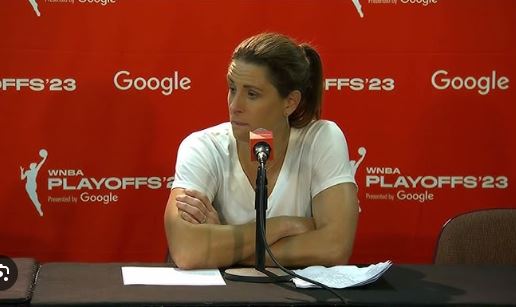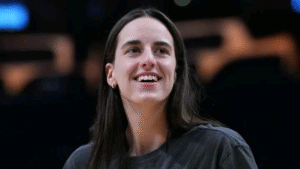
Caitlin Clark’s Perspective on Turnovers and Risk-Taking: A Deep Dive into the Indiana Fever Star’s Mindset
In professional basketball, the word “turnover” is often uttered with a grimace. It’s one of those statistics that can make or break a game, shift momentum in an instant, and in the eyes of many coaches, become a glaring red mark on a player’s performance sheet. For point guards especially — the floor generals, orchestrators of offense, and primary ball handlers — turnovers can be particularly damaging to one’s reputation.

But for Caitlin Clark, the Indiana Fever’s young superstar guard, turnovers are not a source of sleepless nights or lingering self-doubt. Instead, they’re an accepted byproduct — even a badge of her fearless approach to the game.
During her appearance on Sue Bird’s podcast, “Bird’s Eye View”, the 23-year-old second-year phenom addressed her tendency to rack up turnovers with a refreshing candor that may surprise some observers. Clark’s words revealed not only her self-awareness but also the philosophy underpinning her bold, high-tempo style of play — one that has both captivated fans and sparked debate across the basketball community.
Embracing the Risk Factor
The reality of Clark’s numbers is undeniable: she sits near the top of the WNBA’s turnover charts. For many players, such a stat would be a flashing red warning sign — an area to urgently correct before it overshadows other contributions. Yet for Clark, the turnovers are simply the price of admission for the creative, attack-oriented basketball she thrives on.
Her game has always been built around pushing the pace, making audacious passes, and taking shots most players wouldn’t even attempt. That means there will inevitably be moments where the ball ends up in the wrong hands. To Clark, that’s not a sign to slow down — it’s a sign she’s staying true to her identity.
“I bet if you look up my turnovers in college,” Clark told Bird with a knowing smile, “I bet I led the NCAA all-time in turnovers in my career. I’m not saying it’s a good thing to brag about, but it’s just how I play.”
This acknowledgment encapsulates Clark’s outlook: turnovers are not a flaw she ignores, but neither are they an obstacle that will force her to abandon her instincts.
Looking Back at a Bumpy but Bold Start
Sue Bird, a WNBA legend herself and one of the greatest point guards the sport has ever seen, brought up a notable example from Clark’s early professional career: her much-anticipated WNBA debut. That game, heavily hyped and broadcast nationwide, featured Clark showcasing her scoring talent — but also racking up ten turnovers.
For some rookies, such a stat line on the biggest stage could have been mentally crushing. Bird asked, “How did a ten-turnover game not affect your ability to still go out and playmake?”
Clark’s answer was delivered with humor and honesty:
“Well, I will say, I apologized to the team after that game in the locker room,” she said, laughing along with Bird.
That self-deprecating approach reflects her confidence. Rather than dwelling on the mistakes, she’s quick to move forward, understanding that the value she brings to the court extends far beyond any single number in the box score.
The Basketball Community’s Debate
Clark’s turnover issue has become one of the most discussed aspects of her young career. Analysts, fans, and fellow players have weighed in, often debating whether her high turnover rate is a weakness to be fixed or evidence of the daring creativity that makes her so special.
Some see it as a sign she’s still adjusting to the speed and defensive intensity of the WNBA, especially given that she missed more than half of her sophomore season due to injuries. Others argue that turnovers are simply inevitable for players with her level of responsibility and ambition — particularly those willing to make passes that thread the needle between multiple defenders.
For Clark, the truth lies somewhere in the middle. She acknowledges the need to improve in this area, and she believes she already has made strides in smarter playmaking this season. Still, she refuses to strip away the very qualities that have made her game electrifying since her days at Iowa.
Risky Passes and “Logo Bombs”
Clark’s offensive repertoire extends far beyond her famed deep three-pointers — shots launched from several feet beyond the arc, sometimes even from the midcourt logo, that have earned her the nickname “Logo Cait” among fans. While those shots grab headlines and fill highlight reels, her passing is just as much a spectacle.
From full-court baseball throws to cross-court lasers delivered over the heads of defenders, Clark’s assists often require a combination of vision, timing, and courage. But the same ambition that creates jaw-dropping highlights also invites occasional disaster.
“Maybe it’s a toxic part of me, but I always think it’s going to go well,” Clark said of her mindset before firing one of these high-risk passes. “And then I throw it and it doesn’t go well.”
She grinned before adding: “I definitely have some delusion — and all the good players have delusion. Like that’s just the truth. You have to think you’re better than you actually are at the end of the day.”
The “Delusion” of Greatness
This idea of “delusion,” as Clark puts it, is not about being out of touch with reality but about maintaining an unwavering belief in one’s ability to make the impossible happen. For elite athletes, confidence often walks a fine line between rational optimism and an almost irrational trust in their own skills.
Clark’s confidence fuels her willingness to attempt plays that most guards would consider too risky. And while not every attempt works out, those that do often result in momentum-shifting moments — plays that energize teammates, ignite the crowd, and force opponents to adjust their defensive strategies.
It’s why fans tune in to watch her, why her jersey sales are among the league’s highest, and why every Fever game feels like must-see basketball.
Injuries, Growth, and the Next Step
Clark’s second WNBA season has been far from smooth. A series of injuries kept her sidelined for more than half the year, limiting her opportunities to build continuity with her teammates. Despite that, she’s shown an evolution in her decision-making and court vision during the games she has played.
She’s learning when to press the accelerator and when to pull back slightly, when to unleash the cross-court bullet and when to opt for the safer swing pass. But she’s determined never to abandon the essence of her game — the creativity, boldness, and flair that made her a star in college and have now carried her into professional stardom.
Why Fans Can’t Look Away
While turnovers may be statistically undesirable, the truth is that for players like Caitlin Clark, they’re part of the entertainment package. Every risky pass has the potential to be either a turnover or an unforgettable assist. Every deep three-point attempt could either clang off the rim or ignite the arena in collective awe.
In many ways, her game mirrors that of legendary NFL quarterbacks like Tom Brady, who Clark jokingly referenced when discussing her long-ball passes. Like a quarterback testing the limits of a defense with deep throws, Clark tests the boundaries of basketball’s playmaking possibilities. And just like in football, when the connection is made, the payoff is exhilarating.
In the end, Caitlin Clark isn’t trying to hide from her turnovers or pretend they don’t happen. She’s embracing them as an inevitable part of a game built on speed, creativity, and an unshakeable belief in her abilities.
Her conversation with Sue Bird offered fans a glimpse into the mindset of a player who understands that greatness requires risk — and that sometimes, the willingness to fail spectacularly is what makes success all the more thrilling.
The turnovers will come. So will the highlights. And for Caitlin Clark, that’s exactly how it’s supposed to be.
Leave a Reply